|
Tags: painting | Shih-Chiao Lee
Li Shiqiao was one important Taiwanese artist early in the Japanese Colonial Period (from 1895 to 1945). He was known for his sincere and careful attitude towards painting, philosophical and critical mind, as well as his unique and superbly skillful painting style. He contributed significantly to art in Taiwan, educating and inspiring quite a few followers who later became excellent artists. After Li Shiqiao’s death, more than four hundred pieces of his works, including oil paintings, water-color paintings, sketches, and their related items, have been preserved in the Li Shiqiao Museum of Art. They are Taiwan’s important cultural assets and should be carefully preserved for future appreciation and study.
Li Shiqiao was a famous Taiwanese oil painter born in Xinzhuang Township, Taipei County, in 1908 and passed away in the United States in 1995. For more than sixty years, he had been engaged in artistic creation. His sincere and serious efforts, his quest for originality, his contemplative mind and critical attitude, combined with his unparalleled painting skills, all contributed to his unique painting style. Let’s see his contributions and significance in the following passages:
- Li Shiqiao and other seven artists (Chen Dengpo, Li Meishu, Yen Shuilong, Yang Sanlang, Liao Jichun, Chen Chingfen, and Zhang Wanchuan) co-founded the Taiyang Art Society and Taiwan Art Exhibition Association, which contributed significantly to the development of art in Taiwan.
- Art historian Xie Lifa once said, “In Taiwan’s art history, Li Shiqiao was like as a bridge. He translated the unique elements in Western masterpieces into general conventions, building a passage that makes the art of painting approachable.” This statement acknowledges Li’s immense contributions in leading the artists of new generations.
- Art historians hailed him as a prize winner in the Di Exhibition (Japan’s national exhibition) and Fine Taiwan Art Exhibition.
In terms of art education, Li Shiqiao also made significant contributions. He was a teacher in the Department of Fine Arts at the National Taiwan Normal University and the National Taiwan Academy of Arts, both being the most prestigious academic organizations in fine arts in Taiwan at the time. Many brilliant young artists in Taiwan had studied with him.
Li Shiqiao devoted his whole life into art and remained engaged in art creation for more than sixty years. With mighty determination and impregnable spirit, he painted a considerable excellent works, which form the most complete collection of western-style paintings in Taiwan at his time. Nowadays, these pieces are considered Taiwan’s treasure. As many as four-hundred-plus oil paintings, water-color paintings, and other related data are now collected in the Li Shiqiao Museum of Art (see below for a portion of his digitalized works). They are important cultural assets and should be carefully preserved for later generations to appreciate and study.
The Council of Cultural Affairs has had two-hundred-plus pieces of Li’s artwork digitalized. In light of Mr. Li’s contributions to Taiwan’s art and for education purpose, his outstanding accomplishments should be thoroughly documented and digitalized, and furthermore be open to the general public. This way, his legacy can be carried on, and so does his selfless devotion into education.
The Digital Archives Project aims to establish the “Li Shiquiao Digital Museum” by digitalizing the collection in the Li Shiqiao Museum of Art. The main tasks are as follows:
- Data compilation and analyses: compile and categorize the paintings, manuscripts, and related data systematically and chronologically, conduct researches on Li Shiqiao’s artist career and painting styles as well as analyses of his intentions behind each of his art creations
- Data digitization: digitalize the related items step by step
- Establishment of Metadata: establish metadata according to standards such as Dublin Core, CDWA, EAD, and RDF
Japanese Girl, 1931

The “ Japanese Girl” was a practice piece Li executed when studying in Japan. At that time, he was not yet adept at using oil paints. Some parts of the face are unnaturally pointy, which are the traces of sketching. The muscles were poorly delineated, as can be seen on the corner of the upper lip, the cheek, and the neck that touches the light. It is shown that Li was a beginner of using oil paints and therefore his sketching skills were not fully brought into play. However, he demonstrates his sensitivity to colors by skillfully applying colors of decent brightness to the background so that they do not distract viewers’ attention from the main subject. The strong contrast between the scarlet background and the green cloth reveals the artist’s preference for bright colors.
Portrait of the Fourth Younger Brother, 1931
 This painting won the Special Selection at the Fifth Anniversary of the Fine Taiwan Art Exhibition. It portrays the fourth son of the Li family, Li Duiduan, wearing fashionable clothes and a hat when he was to join the Dadaocheng grand worshipping ceremony. One can see Cezanne’s influences on the artist in the painting’s well-balanced composition, dense colors, and vivid delineation of the characteristics of human body.
This painting won the Special Selection at the Fifth Anniversary of the Fine Taiwan Art Exhibition. It portrays the fourth son of the Li family, Li Duiduan, wearing fashionable clothes and a hat when he was to join the Dadaocheng grand worshipping ceremony. One can see Cezanne’s influences on the artist in the painting’s well-balanced composition, dense colors, and vivid delineation of the characteristics of human body.
| Portrait of the Oldest Brother (with Boy Scout Hat), 1932 |
Standing Naked Lady, 1935 |
Rose Flowers, 1936 |
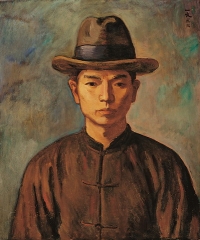
|
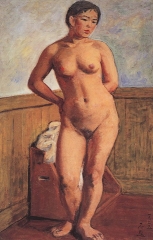
|
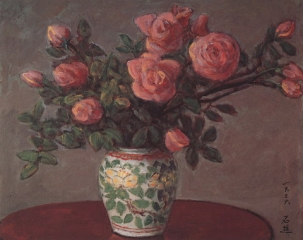
|
| This painting is a half-length portrait of Li’s eldest brother Li Dingzhao. |
Portrayed here is a standing naked lady. A newspaper stand is in the background. |
Pink roses stretch their beauty on the canvas. The ceramic vase with colorful peony design and the round wooden table give an air of Chinese elegance. |
Mrs. Ye, 1937
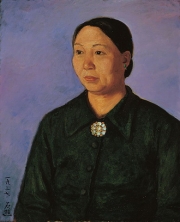 The three-quarter front angle employed in this painting is common in figure painting. The style is realistic. The facial muscles are naturally shown on the plump face. The nose pertinently brings out the facial characteristics of the Chinese people, avoiding the common mistake of imposing a Caucasian nose on an Asian face. The bags under the eyes are appropriately portrayed for a middle-aged woman. The dark blouse is decorated with only a single sparkling brooch. This painting is considered the best figure painting Li created in Taiwan.
The three-quarter front angle employed in this painting is common in figure painting. The style is realistic. The facial muscles are naturally shown on the plump face. The nose pertinently brings out the facial characteristics of the Chinese people, avoiding the common mistake of imposing a Caucasian nose on an Asian face. The bags under the eyes are appropriately portrayed for a middle-aged woman. The dark blouse is decorated with only a single sparkling brooch. This painting is considered the best figure painting Li created in Taiwan.
Still Objects, 1940

Portrait of Father (in Winter Black Coat), 1942
 This portrait silhouettes Li Shiqiao’s father, dressed in a black winter coat. The strokes are subtle and exquisite, and the colors elegant.
This portrait silhouettes Li Shiqiao’s father, dressed in a black winter coat. The strokes are subtle and exquisite, and the colors elegant.
Portrait of Father (in Summer Cloth), 1942
 This painting, realistic in style, best shows Li Shiqiao’s application of colors in figure painting. The dry rub technique [rub the canvas with pigment-loaded cloth] is used to present the texture of the flax linen and show the man’s vivid facial expression. The face and hair were drawn using relaxed and loose strokes to form harmony with the cloth. This person looks quite like Li Shiqiao himself. The slight curve of the chair echoes that of the shoulders, while the straight line of the wall shows a liaison with the button line of the Chinese-style tunic. One can observe the artist’s attention to the geometry of objects in this painting.
This painting, realistic in style, best shows Li Shiqiao’s application of colors in figure painting. The dry rub technique [rub the canvas with pigment-loaded cloth] is used to present the texture of the flax linen and show the man’s vivid facial expression. The face and hair were drawn using relaxed and loose strokes to form harmony with the cloth. This person looks quite like Li Shiqiao himself. The slight curve of the chair echoes that of the shoulders, while the straight line of the wall shows a liaison with the button line of the Chinese-style tunic. One can observe the artist’s attention to the geometry of objects in this painting.
Li Shiqiao’s Studio, 1947
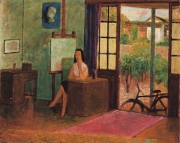 This painting is a quiet corner of Li’s studio against the light. The vibrant greenery outdoor forms contrast with the lady sitting alone in an open room with simple layout. A dim yellow light fills the room with a mysterious atmosphere.
This painting is a quiet corner of Li’s studio against the light. The vibrant greenery outdoor forms contrast with the lady sitting alone in an open room with simple layout. A dim yellow light fills the room with a mysterious atmosphere.
Portrait of Father, 1948
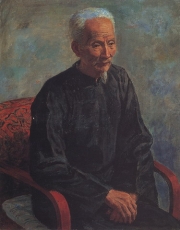 (Compare and contrast with the Portrait of Mother-in-Law)
(Compare and contrast with the Portrait of Mother-in-Law)
Li Shiqiao did portraits of his father and mother-in-law, both in realistic style. Similar gestures are shown in these two portraits as both figures sit facing slightly to the right. The way their hands placed is similar, except for which one of the hands is up or down. The drawing of his father’s hands is marvelous, and his face is more natural than his mother-in-law. While this work is realistic, it exhibits rich colors. In the Portrait of Mother-in-law, a contrast is made between the red turban and the dark blue cotton-padded coat; in the Portrait of Father, the red chair contrasts with the dark blue tunic suit. The contrasts not only add to the colorfulness of both paintings but the texture of the clothes is intensified. The simple background is enhanced by subtle changes in hue, save that in the Portrait of Mother-in-law the colors show distinct patches of brushstrokes.
Portrait of Mother, 1948
 Portrait of Li Shiqiao’s mother in black cloth, her face solemn
Portrait of Li Shiqiao’s mother in black cloth, her face solemn
Portrait of Mother-In-Law, 1948
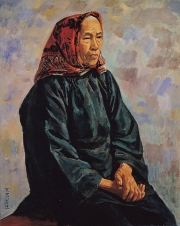 (Compare and contrast with the Portrait of Father)
(Compare and contrast with the Portrait of Father)
Li Shiqiao did portraits of his father and mother-in-law, both in realistic style. Similar gestures are shown in these two portraits as both figures sit facing slightly to the right. The way their hands placed is similar, except for which one of the hands is up or down. The drawing of his father’s hands is marvelous, and his face is more natural than his mother-in-law. While this work is realistic, it exhibits rich colors. In the Portrait of Mother-in-law, a contrast is made between the red turban and the dark blue cotton-padded coat; in the Portrait of Father, the red chair contrasts with the dark blue tunic suit. The contrasts not only add to the colorfulness of both paintings but the texture of the clothes is intensified. The simple background is enhanced by subtle changes in hue, save that in the Portrait of Mother-in-law the colors show distinct patches of brushstrokes.
Portrait, 1949
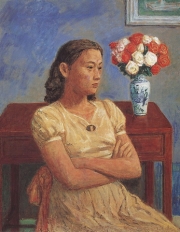 Breaking away from the realistic style in Construction, the artist embraced in this painting a style near to classism, one much like the Picasso’s. This painting is quite stylized; the folded arms fit well with the torso. The ivory color of the dress creates an impression of a solid and firm marble sculpture or a plaster figure. However, the desk and the vase in the background, drawn in realistic style, are not in congruousness with this stylized main subject. This painting marks a change in Li’s painting style.
Breaking away from the realistic style in Construction, the artist embraced in this painting a style near to classism, one much like the Picasso’s. This painting is quite stylized; the folded arms fit well with the torso. The ivory color of the dress creates an impression of a solid and firm marble sculpture or a plaster figure. However, the desk and the vase in the background, drawn in realistic style, are not in congruousness with this stylized main subject. This painting marks a change in Li’s painting style.
|
 The “Japanese Girl” was a practice piece Li executed when studying in Japan. At that time, he was not yet adept at using oil paints. Some parts of the face are unnaturally pointy, which are the traces of sketching. The muscles were poorly delineated, as can be seen on the corner of the upper lip, the cheek, and the neck that touches the light. It is shown that Li was a beginner of using oil paints and therefore his sketching skills were not fully brought into play. However, he demonstrates his sensitivity to colors by skillfully applying colors of decent brightness to the background so that they do not distract viewers’ attention from the main subject. The strong contrast between the scarlet background and the green cloth reveals the artist’s preference for bright colors.
The “Japanese Girl” was a practice piece Li executed when studying in Japan. At that time, he was not yet adept at using oil paints. Some parts of the face are unnaturally pointy, which are the traces of sketching. The muscles were poorly delineated, as can be seen on the corner of the upper lip, the cheek, and the neck that touches the light. It is shown that Li was a beginner of using oil paints and therefore his sketching skills were not fully brought into play. However, he demonstrates his sensitivity to colors by skillfully applying colors of decent brightness to the background so that they do not distract viewers’ attention from the main subject. The strong contrast between the scarlet background and the green cloth reveals the artist’s preference for bright colors.























